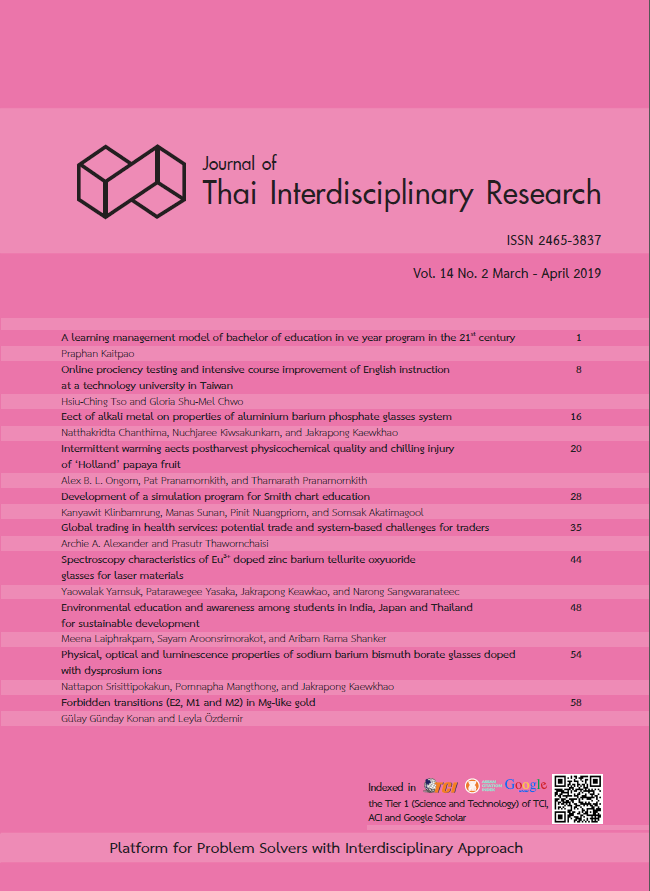Development of a simulation program for Smith chart education
Main Article Content
Abstract
The research in this paper describes the development of simulation program for Smith chart education which was designed to be as an instructional media in telecommunication engineering course. The simulation that was developed is based on the GUI-MATLAB program. It consists of a GUI (Graphical User Interface) input parameter window, a calculating menu, and a graphical display window for use of Smith chart in transmission line. The performance of the simulation that was developed was evaluated by 5 experts. They found it to be at appropriated level for the students it was aimed at (mean equaled to 4.21 and S.D. equaled to 0.08). After implementing use of the simulation software in classroom at department of teacher training in electrical engineering, faculty of technical education, King Mongkut’s University of Technology North Bangkok, the students’ satisfaction to towards using the simulation as assessed. It was found to be at a high level giving an average result of 4.18 of the maximum 5 points. The simulation program was found to have an eciency equal to 1.02 which is in agreement with the standard criteria of Meguigans’s formula [8]. In conclusion, the simulation can be used appropriately in the teaching of transmission line course. Moreover, as well as meeting its teaching aims it helps the learner to develop wider learning skills such as understanding and analyzing.
Article Details
References
B. S. Bloom, Taxonomy of education objectives handbook I :Cognitive domain, New York: David McKay Company, 1956.
K. Klinbumrung, et al. Development of REPEA learning model based on STEM T education, The International STEM Education Conference (2015) 123–126.
M. Frydenberg, D. Andone, Learning for 21st century skills,Information Society (2011) 314–318.
J. W. Pellegrino, M. L. Hilton, Education for life and work: Developing transferable knowledge and skills in the 21st century,National Academy Press, 2012.
D. Reeping, K. Reid, STEM academies and their effect on student perceptions of engineering, in: IEEE International conference on Frontiers in Education, 2014.
D. M. Pozar, Microwave engineering, Addison Wesley Publishing Company, United States of America (1993).
D. M. Smith, Engineering computation with MATLAB, New York, 2010.
K. Klinbumrung and S. Akatimagool, The development of STEM based instructional tools for transmission line engineer-ing courses, in: IEEE International Conference on Teaching,Assessment, and Learning for Engineering, 2016, pp. 319–322.
N. Chumchuen, S. Akatimagool, and M. Wangsathitwong, Professional experience teacher training based on creative thinking competency using the KWSLPA learning model, Journal of Thai Interdisciplinary Research 12 (2017) 27–34.
W. Weerasin, S. Akatimagool, The development of MIASCE learning model based on the creative problem solving process for electromagnetic wave education, in: IEEE International Conference on Teaching, Assessment, and Learning for Engineering, 2016, pp. 328–331.
S. Khamkleang, S.Akatimagool, Microwave planar circuit design tool in the teaching of microwave engineering, in: Electrical Engineering/Electronics, Computer, Telecommunications and Information Technology, 2009, pp. 5–7.
S. Khamkleang, W. Nuansoi, Analysis of microstip low-pass elliptic filter by wave iterative method (WIM), in: Engineering and Technology, 2012, pp. 1–4.
P. Nuangpirom, et al., Analysis of dual band dipole antenna using WIM algorithm, in Asia-Pacific Conference on Antennas and Propagation, 2013, pp. 147–148.
K. J. Reid, E. Baumgartner. Work in progress - putting the “E”in STEM teacher preparation: A new bachelor of science de-gree with an engineering education major, in: 41stASEE/IEEEFrontiers in Education Conference, 2011.
N. K. M. Land, Full STEAM ahead : The benefits of inte-grating the arts into STEM, Procedia Computer Science (2013)547–552.
G. H. Jia-shen, M. J. Lancaster, Microstip Filter for RF/Mi-crowave Application, New York, 2001


